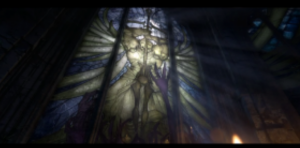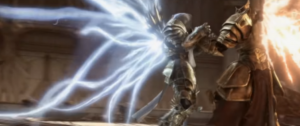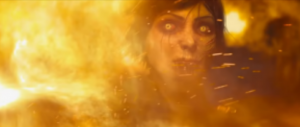63 Diablo III (2012)
The Deception of DPD in Diablo III
By Sarah Staggs
It’s 1997 and the newest PC game is set exploring dungeons on your path to find and defeat Diablo in the depths of Hell. Fast forward 24 years, and Diablo is still a major craze on multiple platforms. The additions of Diablo II, Diablo III, and Diablo II Resurrected have made their way to the masses. As of this writing, we anxiously await Diablo Immortal, which will allow us to follow a new journey of maps, battles, bosses, and the ever popular cinematic moments through a new era on our phones, wherever we go. Diablo offers you the best of both worlds with its unique gameplay and epic cutscenes. This game tells a story that you won’t want to miss. The story is told through a mixture of interactive gameplay, involving talking with non-player characters, (NPC’s), through battles with the demon lords of Hell, Diablo himself, and the angel of Death, as well as through high-quality cutscenes that give you the sense you’re really witnessing the events pan out. Diablo was produced by Blizzard Entertainment, and while it has come a long way in what it has to offer, it can be perceived that the game reflects, in some aspects, the company that produced it. Said company was just under a heavy lawsuit and worldwide strike, as it was revealed a female employee committed suicide, due to the sexual harassment of co-workers and unequal treatment in the workplace.
The aspect of sexualizing women by Blizzard entertainment has been a long-standing aspect in their video games. Over the years, the quality of sexism/racism has changed, however, the original character options were minuscule. There was the white man warrior, the skimpily dressed female rogue, and the burly black male mage. As the story goes, the Warrior is the only character to be successful, as he defeats Diablo and saves the day. The female character is easily corrupted by one of the evil characters, and the mage is driven mad by his journey from his homeland. Moving forward to the second game, this still took place. The classes were gender-locked and tended toward stereotypes. The women were designed with sexualized outfits, and instead of wearing armor like their male counterparts, had skimpy pieces of cloth.
Within the cinematics, we see a more elaborate picture though. The cutscenes display these ideas of power, difference, and discrimination through means of fictional characters and literal monsters. In our opening video for Diablo III we see the desolation of a town, haunted by shadows and bones, somber music is playing, and we get this morbid feeling. Next, it cuts to a war drum and a scene of literal monsters, charging into a war. This cutscene is started in a storybook fashion. We see the monsters and this battle between these bright figures, (angels), and these dark figures, (demons), written out like a comic book. There is a narration of Cain, who depicts the ensuing danger verbally, portraying good vs. bad. Visually we see this as the ‘good’ characters being light and pure and descending from the Heavens, while the ‘bad’ characters are dark forces that bust through the ground ascending from Hell. The video then cuts to the Cathedral, where two of the characters, Cain and Leah, are talking about this scene about to play out. The church has low lighting to depict the impending doom. Audio gives us cues of suspense. Suddenly, light is shining through the stained glass windows of an angel, and we get this foreshadow that something major is about to happen, something much, much bigger than these initial characters themselves.

The next edit shows a fiery ball shooting out of the sky through the window of the church, hitting Cain and dragging him down through the depths of the Cathedral. We later find out that this is actually Tyrael, the angel of justice, depicted with dark skin, who relinquished his power to side with the humans, and fell from Heaven after ripping off his own wings. This scene plays out in the Act II cutscene, where we see Tyrael arguing with the archangel Imperius, (who is never visually revealed, but is voiced by a white actor), also known as the aspect of Valor, who tells our angel of justice that he was in the wrong for providing aid to the mortal race. Tyrael rebuttals this with, “You cannot judge me, I am justice itself” (Diablo). This displays a difference in power and discrimination between the angels, (Imperius thinks he is better than Tyrael, who is his equal), the angels and the humans, (Imperius tries to punish Tyrael for helping a ‘lesser’ species), and between races,

(Imperius is portrayed by a white man, Tyrael is portrayed as black). The next edit has Leah talking to Tyrael about how he chose to become human and give up his angel powers because he would rather be human than sit back and watch humanity fall, because as he puts it, “humanity, is the only hope…”(Diablo). Imperius is portrayed as being superior to all, as a white-voiced angel, and talks down to the angel that should be his equal, simply for trying to help a ‘lesser’ race, humanity. Tyrael counters this by implying that humans can do what the angels cannot, and they are the superior race.
Another instance of difference and discrimination is when you start Act 1, (of 5 acts). There is another brief storybook tale, describing your character and why they got to where they are, needing to fight in the battle. I chose the black witch doctor character. This could be seen as a stereotype, that because the class is witch doctor, it’s automatically a black character. This is what someone would think if they took it at face value of what society has told them. Witch doctors actually originated in Europe in the 1800s, as those that opposed magic; it wasn’t until the 1900’s that Africa had ‘shamans’ that depicted the herb using witchcraft of modern-day witches, which is depicted in the game. He’s displayed as super disheveled, not as bulky as other classes, and seeming almost as possessed. If we want to make this a matter of discrimination, we could say the company seems to intentionally create this character as a black stereotype and it’s super racist. Otherwise, it’s just a character that took inspiration from a depiction of a witch doctor that the creator liked. As stated in Understanding Video Games: The Essential Introduction, “Expressions of taste of distaste about a new medium are not just objective judgment, even though they may appear so; they are probably strategic or power-related.” With this ideology, we could assume that it was a crack at Africans as being weak, raggedy, or possessed, such as the witch doctor portrayed.
In Act 4, there is another scene that goes back to Imperius, standing on the Gates of Heaven, with Leah in front of him. This portrays that difference in power once again, but then levels the playing field descending to the platform in front of the gate. Imperius greets Leah as his old enemy and implies that it’s not her true form. Leah’s face no longer looks human, it’s taken on this dark aspect, her eye color has changed, portraying this new demonic power. Imperius, who is still embodied within a bright light, attacks Leah, forcing her human shell to melt away in a burst of flames, revealing instead a much larger, dark figure, Diablo, the King of Hell himself. This figure looms over Imperius, indicating once again a difference in power, proven when Diablo swiftly disposes of Imperius. With the fall of Imperius, the embodiment of the white light, the gates of Heaven also fall to Diablo, the embodiment of darkness.

Within the gameplay, the story continues. You, as the nephalem, (human/angel or human/demon hero character), defeat Diablo to save the world. Tyrael was somewhat right, and the human race was superior to the Angels and the Demons. In a dramatic scene following the death of Diablo, Tyrael in Heaven ascends to join his angel brethren but does so as a mortal. He implies that justice has been served, so he will no longer be the angel of justice, but instead the angel of Wisdom, as equals, side by side with humanity. They overcome this difference in power. He sets forth to stop the discrimination between humans and angels. In Act V we learn this peace does not last. Here we take on our strongest enemy yet, the angel of death, Malthael, who embodies both light and dark. In the act’s starting cinematics, we see Tyrael and Malthael in front of the soulstone, the item that conjures all evil in the game. The setting involves low lighting to portray this idea of corrupt power, narrow frontal frames to specify the importance of each character, and camera panning important perspectives. The clip moves in this Hollywood style of showing our main character, then who he is looking at, then back to our character, then back to his view. We then see the view back out to a larger depth so we can see the angel of death kill the guards in front of him. Instead of portraying this angel as light, he is seen with grey wings made of smoke, as death is often seen as kind of a grey character, offering peace for some and loss for others. Tyrael tries to stand his ground, using a weapon that releases light, but it is swiftly overcome by the grey. He attacks the angel but is met with heavy opposition, as his blade passes through his brother. The difference in power is made evident here through body language. Tyrael stands his ground, but fear is obviously written across his face as his guards are swiftly killed in front of him. Meanwhile, Malthael shows no emotion, and easily consumes the life force of everyone in the area. Tyrael’s life force is once more portrayed as a bright light that is consumed by the darkness that is his brother.
As you can see, if we look for difference, power, and discrimination, we can find it anywhere. My question to you, is where do we draw the line? I feel that we should appreciate people’s differences the way Tyrael does, and realize that one character cannot portray every person within the umbrella of one term. In the young adult dystopian novel, The Giver, we see portrayed a community that stopped at nothing to remove difference, power, and discrimination. They went so far as to remove the memories of all things that brought joy, pain, love, and emotions that make us human. Over generations, they convinced the people of the community to take a drug every day that removed their feelings and willpower to fight back. The community essentially became a breeding program, where the people existed as lifeless humans, were assigned a spouse, job, and children, and when they were too old to be productive they were ‘released’, which was the book’s way of saying euthanized. However, in The Giver, people were pretty much equal, and there was no discrimination because the citizens couldn’t see difference, (not even hair color or skin color). Is that too far? Why is it only racist to depict a black man as poor, and not racist to depict a white man as the same? In Diablo we see both representations made, but only the black man would be looked at harshly. “We relinquished color when we relinquished sunshine and did away with differences” (Lois, 95). How much should we relinquish in our world? Should we have to give up every aspect of our life that makes us unique and sentient, in order to appease the brittle emotions of others?
Throughout Diablo III we see Tyrael, a dark-skinned angel, fighting against all levels of difference, power, and discrimination, to recognize the beauty in all. From the immense power of a human in the face of angels and demons to the love and compassion for even the angel of death, Tyrael targets DPD by EMBRACING what makes people different, and beautifying that every person has a unique characteristic that makes them useful, beautiful, necessary, etc. Differences make us human, and I think we need to stop overanalyzing things and making victims where there aren’t any because, in my opinion, that is a horrible way to treat someone. We are so quick to judge a character in a movie or game as not being the way WE think that character should be portrayed, based on their color, class, religion, etc. In that way, we as the audience, are making biased judgments based on our perception of the character’s cover, not reading their story and you know what they say…. You shouldn’t judge a book, (character), by its cover, (appearance).
REFERENCES
Diablo III. , 2013. Computer game. Blizzard Entertainment.
Egenfeldt-Nielsen, Simon, et al. Understanding Video Games : The Essential Introduction, Taylor & Francis Group, 2012. ProQuest Ebook Central, https://ebookcentral.proquest.com/lib/linnbenton-ebooks/detail.action?docID=1181119. Lowry, Lois. The Giver. HarperCollins, 2014.

